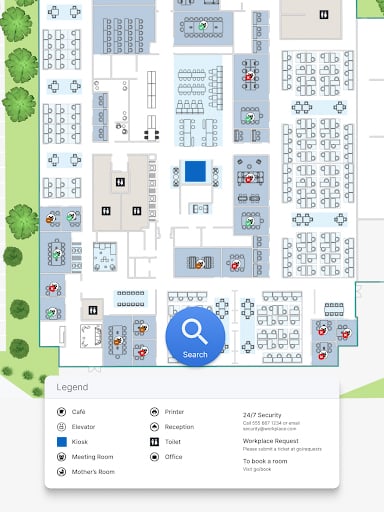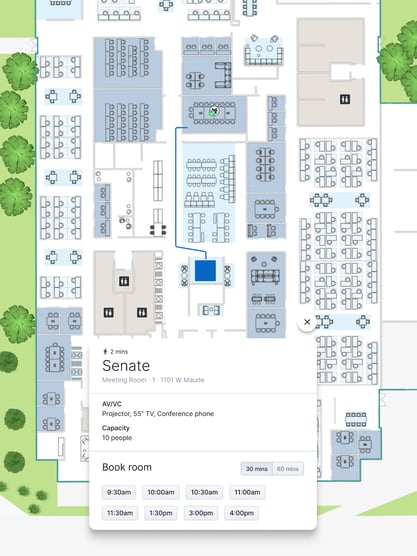Most companies will agree that to not fall behind in the industry, new initiatives and implementations of new technologies and systems are sometimes necessary.
A way to not only implement new technologies but also enhance the existing ones by combining them all into one platform is to invest in a dynamic mapping platform. In this blog, we will list for you five benefits that a dynamic mapping platform will bring to your business.
#1 Time optimization
.jpg?width=326&name=computer_iPhone_Austin%20(1).jpg)
The main issue with large and complex buildings is that it’s easy to get lost in them. In large offices, employees, as well as guests, often need to spend valuable time trying to find their way from one place to another. With a dynamic mapping platform, employees and guests alike can smoothly be led to their point of destination, be it meeting rooms, restrooms, or cafeterias.
In other industries such as airports, shopping malls, or stadiums, this easy form of navigation could result in an overall improved customer experience. By enabling travelers and guests to easily navigate the venue, you will offer them a chance to relieve themselves of stress and frustration from not knowing where to go and how long it will take to get there. Instead, giving guests a way to better manage their time will give them more time to explore available shops and restaurants at your venue which will positively impact sales.
#2 Reduce costs
The annualized cost for one single workstation in one calendar year is estimated to go up to as much as $18,000. With 70% of employees working remotely at least once a week, desks are left unused 20% of the time. In companies with hundreds or thousands of employees, are the costs of unutilized office space worth it?
We’ve previously touched upon the topic of hybrid working and how it’s become a trend during the pandemic - and possibly will stay one after it as well. By changing the office layout from offering fixed workstations to shared desks, you will be able to cut down on a large amount of unutilized office space. And while this might seem like a big task with a lot of administration - it isn’t. With a dynamic mapping platform, you can integrate your indoor navigation maps with your space management systems and get an instant overview of available desks as well as where your colleagues are located.
#3 Enhance productivity and employee satisfaction
Studies have shown that office workers spend an average of 11 minutes focused on a task before they’re interrupted. Additionally, it then takes them an average of 25 minutes to get back to the point they were at before they were interrupted in the first place. Even if it isn’t noticeable to some, the time wasted on distractions will over time add up to large numbers. Modern office spaces can be complex and for guests, the only way to make their way around can be to ask employees for directions. While distractions, in general, are inevitable and natural, indoor navigation can empower visitors to be more self-reliant upon visiting the office and thus reduce the number of interruptions.
MapsIndoors can be integrated into your existing applications as well as it can stand on its own. It’s possible to integrate the platform into kiosks in your reception areas and allow guests to easily search for points of interest and get the directions sent directly to their phone.
#4 Combine data and visualize it on the map
MapsIndoors makes it possible to make dynamic integrations with third-party data systems. Often large facilities have a lot of different systems used for daily tasks. Take something like room booking features in an office. Usually, booking systems will be linked to the company calendar through which you then can book the room or desk you wish. With MapsIndoors, you can integrate MapsIndoors into your company’s calendar systems to ensure an efficient and easy way of managing and booking meeting rooms.
In short, this means that MapsIndoors can combine otherwise segregated data. Users will be able to see data visualized on the map which enables them to make quick and informed decisions as they’ll no longer have to search elsewhere for the information they need. This also can be used for other features such as heat mapping to be able to identify the number of people in the same space, as well as current wait times at points of interest like concession stands in stadiums and security checks in airports.


#5 Maximise the use of resources
With dynamic integrations, MapsIndoors can help users identify large queues and choose a nearby alternative to avoid the crowds. In turn, this also allows management to for instance deploy more staff to a certain area.
This also benefits facility and cleaning management, as it becomes possible to track how many people have been using the same spaces within a certain amount of time. People tend to use similar, known places (like public restrooms) while visiting a particular location. With integrable systems, the MapsIndoors platform can send cleaning management notifications when the number of visitors in a restroom reaches a certain amount and that way ensures consistent and optimized cleaning of the facility.
Are you interested in hearing more about how a dynamic mapping platform can benefit your business? We're always more than ready to assist you with any questions you might have, so don't hesitate to reach out.
May 10, 2021
.png)



.png)